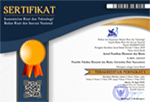The Role of Good Corporate Governance in Moderating the Effect of Financial Ratio on Financial Distress (Study of Consumer Sector Companies Listed on the Indonesia Stock Exchange Over Period 2018-2020)
DOI:
https://doi.org/10.33633/jpeb.v8i1.6409Abstract
Financial distress is a condition where management fails to manage company finances. This study aims to determine the effect of leverage, net profit margin, liquidity, and sales growth on financial distress with corporate governance as a moderating variable. This sample used all consumer goods sector companies listed on the Indonesia Stock Exchange for the 2018-2020 period. Sampling was used with the purposive sampling technique and selected 25 companies. Data analysis used multiple linear regression and the absolute difference value test. The results are that the variables of leverage, net profit margin, and liquidity affect predicting financial distress. Meanwhile, sales growth does not affect financial distress. As measured by managerial ownership, corporate governance can moderate the effect of liquidity on financial distress. Still, it cannot moderate the effect of leverage, net profit margin, and sales growth on financial distress. Keywords:leverage, net profit margin, liqudity, sales growth, financial distress, good corporate governanceReferences
Amanda, Y., & Tasman, A. (2019). Pengaruh Likuiditas, Leverage, Sales Growth dan Ukuran Perusahaan Terhadap Financial Distress Pada Perusahaan Manufaktur yang Terdaftar di Bursa Efek Indonesia (BEI) Periode 2015-2017. Jurnal Ecogen, 2(3), 453. https://doi.org/10.24036/jmpe.v2i3.7417
Balasubramanian, S. A., Radhakrishna, G. S., Sridevi, P., & Natarajan, T. (2019). Modeling corporate financial distress using financial and non-financial variables: The case of Indian listed companies. International Journal of Law and Management, 61(3–4), 457–484. https://doi.org/10.1108/IJLMA-04-2018-0078
Fajriana, N., & Kaluge, D. (2019). Menganalisa Financial Distress Pada Perusahaan Perdagangan Ritel (Vol. 2, Issue 2). https://ejournal.stiedewantara.ac.id/index.php/JAD/issue/view/43Hal108-122
Finishtya, F. C. (2019). THE ROLE OF CASH FLOW OF OPERATIONAL, PROFITABILITY, AND FINANCIAL LEVERAGE IN PREDICTING FINANCIAL DISTRESS ON MANUFACTURING COMPANY IN INDONESIA. JURNAL APLIKASI MANAJEMEN, 17(1), 110–117. https://doi.org/10.21776/ub.jam.2019.017.01.12
Firasari & Saparila. (2018). Penggunaan Rasio Profitabilitas, Likuiditas, Leverage dan Arus Kas Untuk Memprediksi Financial Distress Pada Perusahaan Sektor Aneka Industri di BEI. Jurnal Administrasi Bisnis, 61(2), 137.
Giarto, R. V. D., & Fachrurrozie, F. (2020). The Effect of Leverage, Sales Growth, Cash Flow on Financial Distress with Corporate Governance as a Moderating Variable. Accounting Analysis Journal, 9(1), 15–21. https://doi.org/10.15294/aaj.v9i1.31022
Hakim, M. Z., Abbas, D. S., & Nasution, A. W. (2020). PENGARUH PROFITABILTAS, LIKUIDITAS, LEVERAGE, KEPEMILIKAN MANAJERIAL, DAN KEPEMILIKAN INSTITUSIONAL TERHADAP FINANCIAL DISTRESS(Studi Empiris Pada Perusahaan Sektor Property & Real Estate Yang Terdaftar di BEI Periode 2016-2018). Competitive Jurnal Akuntansi Dan Keuangan, 4(1).
Jaafar, M. N., Muhamat, A. A., Alwi, S. F. S., Karim, N. A., & Rahman, S. binti A. (2018). Determinants of Financial Distress among the Companies Practise Note 17 Listed in Bursa Malaysia. International Journal of Academic Research in Business and Social Sciences, 8(11), 800–811. https://doi.org/10.6007/ijarbss/v8-i11/4956
Komala, F., & Triyani, Y. (2020). Analisis Rasio Keuangan Terhadap Financial Distress Dengan Struktur Kepemilikan Sebagai Variabel Moderasi. Jurnal Akuntansi, 8(2), 176–205. https://doi.org/10.46806/ja.v8i2.619
Murni, M. (2018). ANALISIS FAKTOR-FAKTOR YANG MEMPENGARUHI TINGKAT FINANCIAL DISTRESS PADA PERUSAHAAN MANUFAKTUR YANG TERDAFTAR DI BEI TAHUN 2010-2014. Jurnal Akuntansi Dan Bisnis, 4(1), 74–83.
Oktariyani, A. (2019). Analisis Pengaruh Current Ratio, DER, TATO dan EBITDA Terhadap Kondisi Financial Distress Pada Perusahaan Manufaktur yang Terdaftar di Bursa Efek Indonesia. 14(1), 111–125. www.ekbis.
Ramadhan, S. (2017). ANALISIS PENGARUH STRUKTUR KEPEMILIKAN, KOMISARIS INDEPENDEN, KARAKTERISTIK PERUSAHAAN DAN RASIO KEUANGANTERHADAP KONDISI FINANCIAL DISTRESSPADA PERUSAHAAN PUBLIK.
Setyobudi, A. D. A. (2017). THE ANALYSIS OF LIQUIDITY, LEVERAGE, PROFITABILITY, AND FIRM SIZE INFLUENCE TOWARD THE FINANCIAL DISTRESS WITH GOOD CORPORATE GOVERNONCE AS THE MODERATING VARIABLE IN PT. TELEKOMUNIKASI INDONESIA Tbk. AND PT. INDOSAT Tbk. Adhi. Journal of Management, 2, 121–135.
Sudaryo, Y., & Dkk. (2021). Pengaruh Current Ratio (CR), Debt to Equity Ratio (DER) Dan Net Profit Margin (NPM) Terhadap Financial Distress. EKONAM: Jurnal Ekonomi, 3(1), 12–22. https://www.taylorfrancis.com/books/9781315468884/chapters/10.4324/9781315468891-39
Utami, Y. P. (2021). PENGARUH RASIO KEUANGAN, ARUS KAS OPERASI, DAN STRUKTUR KEPEMILIKAN TERHADAP KONDISI FINANCIAL DISTRESS Pendidikan. Sintaksis?: Jurnal Ilmiah Pendidikan, 1(1).
Yudadibrata, H. B. N., & Soenarno, Y. N. (2016). Analisis Rasio Keuangan Dan Struktur Kepemilikan Perusahaan Dalam Memprediksi Kesulitan Keuangan: Sebuah Riset Empiris Pada Perusahaan Nonkeuangan Yang Terdaftar Di Bursa Efek Indonesia. Jurnal Akuntansi, 10(1), 83–115. https://doi.org/10.25170/jara.v10i1.41
Zulfa, M. Z. (2018). The Ability of Profitability To Moderate the Effect of Liquidity, Leverage and Operating Capacity on Financial Distress (Empirical Study on Retail Companies Registered on Idx 2012- 2017). Prosiding Business and Economics Conference In Utilizing Of, 330–332.
Downloads
Published
How to Cite
Issue
Section
License
The copyright of the received article shall be assigned to the journal as the publisher of the journal. The intended copyright includes the right to publish the article in various forms (including reprints). The journal maintains the publishing rights to the published articles.
This work is licensed under a Creative Commons Attribution 4.0 International License.


.png)









